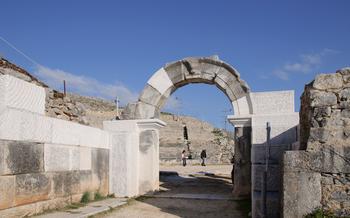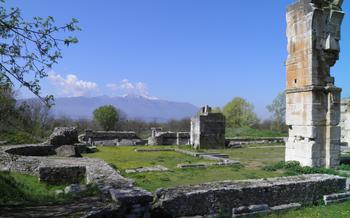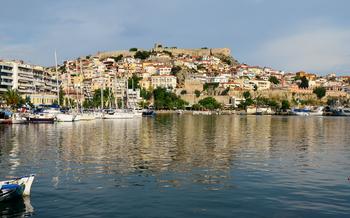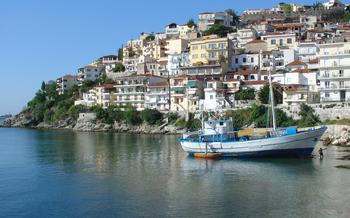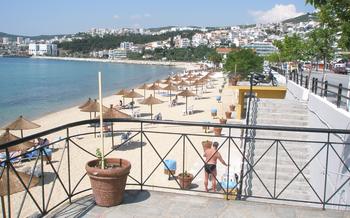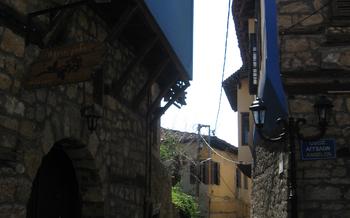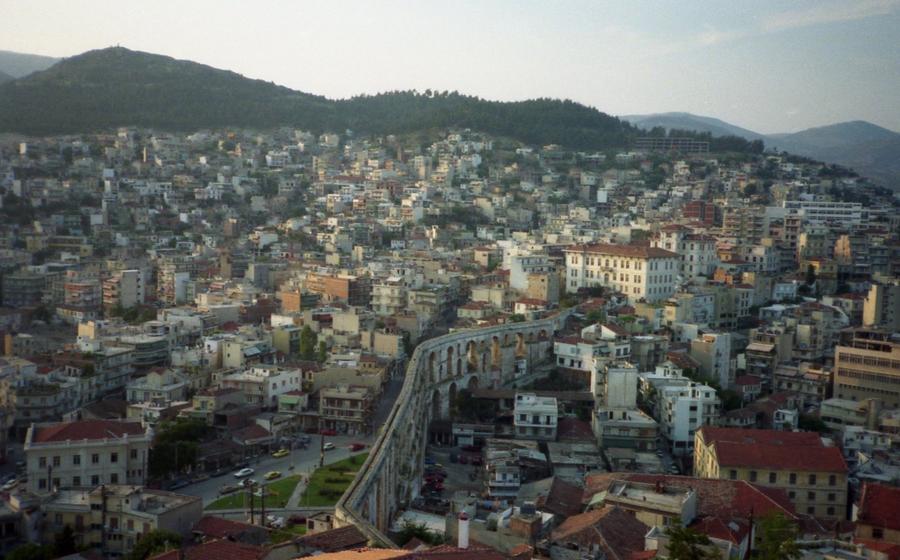
The Walls of the Acropolis of Philippi
- The Walls of the Acropolis of Philippi: A Historical Overview
- Exploring the Walls: A Step-by-Step Guide
- The Eastern Gate: A Gateway to the Past
- The Acropolis: Heart of the Ancient City
- The Theater of Philippi: A Stage for Ancient Performances
- The Agora: A Place of Commerce and Social Interaction
- The Basilica of Philippi: A Legacy of Early Christianity
- The Archaeological Museum of Philippi: A Treasure Trove of Ancient Artifacts
- The Battle of Philippi: A Turning Point in Roman History
- The Apostle Paul in Philippi: A Journey of Faith
- Hiking Trails and Nature Walks: Exploring the Surroundings
- Local Cuisine and Culinary Delights
- Festivals and Events in Kavala: A Celebration of Culture
- Accommodation Options in Kavala: A Range of Choices
- Insider Tip: Unveiling Hidden Gems
The Walls of the Acropolis of Philippi: A Historical Overview
The Walls of the Acropolis of Philippi stand as a testament to the rich history and strategic importance of this ancient city. Built in the 4th century BC by Philip II of Macedon, father of Alexander the Great, the walls served as a defensive fortification protecting the city from invaders. Philippi, located in the region of Macedonia, played a crucial role in ancient Greece as a center of commerce and culture. The construction of the walls reflected the city's growing prosperity and its significance as a strategic military outpost. The architectural style of the walls, characterized by massive stone blocks and intricate masonry, showcased the advanced engineering skills of the ancient Greeks. These impressive fortifications have withstood the test of time, offering a glimpse into the grandeur and resilience of this once-thriving city.
Exploring the Walls: A Step-by-Step Guide
To embark on your exploration of the Walls of the Acropolis of Philippi, begin your journey at the main entrance, where you'll be greeted by the imposing structure of the walls themselves. Take a moment to admire the architectural details and the sheer size of these fortifications. From here, you can proceed along the perimeter of the walls, following the well-defined paths that wind their way through the site.
As you wander along the walls, you'll encounter various towers and gates that punctuate the structure. Each tower served a specific purpose, from providing vantage points for defense to housing soldiers and supplies. The gates, on the other hand, allowed for controlled access to and from the city. Take the time to explore these features, examining their construction and imagining the bustling activity that once took place around them.
Along your walk, keep an eye out for notable features and landmarks. The Eastern Gate, with its intricate carvings and imposing presence, is a must-see. The Theater of Philippi, nestled within the walls, offers a glimpse into the city's cultural life. And the Acropolis, the heart of the ancient city, stands as a testament to Philippi's religious and political significance.
To capture the essence of your visit, don't forget to bring your camera. The Walls of the Acropolis of Philippi offer countless opportunities for stunning photographs. From panoramic views of the surrounding landscape to close-up shots of architectural details, you'll have plenty of chances to document your exploration.
The Eastern Gate: A Gateway to the Past
Among the prominent features of the Walls of the Acropolis of Philippi, the Eastern Gate stands as a monumental gateway that invites visitors to step back in time. This grand entrance, strategically positioned along the eastern side of the fortifications, served as a vital passageway for both people and goods. Its imposing structure, crafted with precision and adorned with intricate architectural details, reflects the grandeur and significance of the ancient city.
As visitors approach the Eastern Gate, they are greeted by its towering archway, flanked by sturdy stone pillars. The gate's threshold is worn smooth by centuries of footsteps, a testament to the countless individuals who have passed through this portal over the millennia. Above the archway, a series of decorative moldings and carvings adds an air of elegance to the structure, showcasing the artistry and craftsmanship of the ancient builders.
Beyond the Eastern Gate, visitors enter a world of ancient history and archaeological wonders. The gate leads directly into the heart of the Acropolis, where a network of cobblestone streets and well-preserved ruins await exploration. Here, visitors can wander through the remains of temples, public buildings, and residential quarters, immersing themselves in the vibrant atmosphere of a bygone era.
The Acropolis: Heart of the Ancient City
Within the protective embrace of the Walls of Philippi, the Acropolis stands as a testament to the city's former glory. Perched atop a hill, it served as the citadel, the religious and political center of ancient Philippi. As you ascend the winding path leading to the Acropolis, the remnants of the past unfold before you.
Once inside, you'll encounter an array of significant buildings and structures that once played a crucial role in the city's daily life. Among them, the Temple of Artemis, dedicated to the revered goddess of hunting, stands out with its impressive columns and intricate carvings. The Agora, the bustling marketplace and civic center, invites you to imagine the lively exchanges that took place within its confines.
The Acropolis also boasts several fortifications, a reminder of its defensive significance. The sturdy towers and bastions, strategically positioned along the perimeter, provided a formidable defense against potential invaders.
As you wander through the Acropolis, take a moment to soak in the panoramic views that stretch out before you. The surrounding landscapes, dotted with olive groves and distant mountains, paint a picturesque tapestry that will leave you spellbound.
The Theater of Philippi: A Stage for Ancient Performances
Amidst the ruins of the ancient city of Philippi, the Theater of Philippi stands as a testament to the cultural and artistic heritage of this once-thriving metropolis. Carved into the hillside, this magnificent structure served as a venue for theatrical performances, musical concerts, and other forms of entertainment that captivated audiences in ancient times.
The theater's impressive size and design speak to the importance of the arts in Philippi. With a seating capacity of over 6,000 spectators, it ranks among the largest ancient theaters in Greece. The carefully crafted seating area, arranged in concentric rows, ensures excellent acoustics and provides breathtaking views of the surrounding landscape.
The stage, adorned with intricate carvings and sculptures, is a work of art in itself. Its raised platform and ample space allowed for elaborate performances, including dramas, comedies, and musical spectacles. The theater's acoustics are remarkable, enabling actors' voices to carry clearly to every corner of the auditorium.
In ancient times, the Theater of Philippi hosted a variety of performances, ranging from classic Greek tragedies and comedies to mimes and musical concerts. These events were not merely forms of entertainment but also played a significant role in religious festivals and civic celebrations. The theater served as a gathering place for the community, fostering a sense of unity and shared cultural experiences.
Today, the Theater of Philippi stands as a silent witness to the vibrant artistic traditions of ancient Greece. Its grandeur and historical significance continue to inspire awe and admiration in visitors who come to explore the ruins of this once-great city.
The Agora: A Place of Commerce and Social Interaction
Within the protective embrace of Philippi's ancient walls, the Agora, a bustling marketplace and vibrant social hub, once throbbed with life. This central square, the heart of the city's commercial and social activities, served as a meeting point for traders, merchants, and citizens alike. Here, amidst the lively exchanges of goods and ideas, the pulse of Philippi beat strong.
The Agora's strategic location, easily accessible from all corners of the city, ensured its pivotal role in daily life. Its spacious layout, adorned with stoas, or covered walkways, provided shelter from the scorching sun or sudden downpours, allowing merchants to display their wares and buyers to browse and haggle at leisure.
Notable structures within the Agora included temples dedicated to various deities, reflecting the deep religious beliefs of the Philippians. These sacred spaces served not only as places of worship but also as centers for community gatherings and celebrations.
The Agora was more than just a marketplace; it was a place where people from all walks of life converged to exchange not just goods but also news, stories, and ideas. Philosophers engaged in lively debates, politicians rallied support for their causes, and artists showcased their talents, creating a vibrant tapestry of human interaction.
As the sun dipped below the horizon, the Agora transformed into a social hub, where locals gathered to catch up with friends, share stories, and savor delicious local delicacies. The air was filled with the aroma of freshly baked bread, grilled meats, and sweet pastries, tempting passersby to indulge in culinary delights.
The Agora, with its vibrant energy and diverse offerings, stood as a testament to the bustling life that once characterized Philippi. Its legacy lives on, inviting visitors to step back in time and experience the essence of an ancient Greek city, where commerce, social interaction, and the pursuit of knowledge intertwined in perfect harmony.
The Basilica of Philippi: A Legacy of Early Christianity
The Basilica of Philippi stands as a testament to the early roots of Christianity in Greece. Constructed in the 5th or 6th century AD, this impressive structure reflects the grandeur and significance of the Christian faith during the Byzantine era. Its construction marked a pivotal moment in the spread of Christianity throughout the region.
Architectural Grandeur and Design The Basilica's architectural style showcases the transition from classical Greek forms to the emerging Byzantine style. Its rectangular plan features three aisles, separated by rows of columns supporting elegant arches. The central aisle, wider than the others, leads to a raised apse where the altar once stood, symbolizing the sacred center of the church.
A Place of Worship and Community Beyond its architectural beauty, the Basilica served as a central hub for the early Christian community in Philippi. It provided a sacred space for religious ceremonies, communal gatherings, and spiritual contemplation. The basilica's spacious interior could accommodate a large number of worshippers, fostering a sense of unity and belonging.
A Witness to History The Basilica of Philippi carries immense historical significance, as it witnessed key events in the early Christian era. It is believed that the Apostle Paul, during his missionary journeys, visited Philippi and may have preached within its walls, leaving an indelible mark on the city's religious identity.
Archaeological Explorations and Discoveries Excavations at the site have unearthed valuable artifacts, including intricate mosaics, marble sculptures, and inscriptions, offering glimpses into the Basilica's rich history and the vibrant Christian community that thrived within its walls. These discoveries have contributed to our understanding of early Christian art, architecture, and religious practices.
A Symbol of Faith and Resilience Today, the Basilica of Philippi stands as a symbol of the enduring legacy of Christianity in Greece. Its ruins, despite the passage of time, continue to captivate visitors with their grandeur and historical significance, serving as a reminder of the deep-rooted faith and resilience of the early Christian community in Philippi.
The Archaeological Museum of Philippi: A Treasure Trove of Ancient Artifacts
Nestled in the heart of Kavala, the Archaeological Museum of Philippi stands as a testament to the rich history and cultural heritage of the ancient city. This treasure trove of ancient artifacts invites visitors on a captivating journey through time, showcasing the splendor and achievements of Philippi's glorious past.
Spread across multiple exhibition halls, the museum houses an extensive collection of artifacts excavated from the ancient city. Exquisitely crafted statues, intricate mosaics, finely detailed pottery, and bronze sculptures adorn the displays, offering a glimpse into the artistic prowess and craftsmanship of Philippi's artisans.
Among the highlights of the collection are the stunning marble statues of Alexander the Great and his wife Roxana, masterpieces of Hellenistic sculpture that exude regal elegance. Visitors can also marvel at the intricate mosaic floors depicting scenes from mythology and everyday life, which once adorned the opulent villas and public buildings of the city.
The museum also features a collection of coins, jewelry, and everyday objects that provide insights into the economic and social life of ancient Philippi. These artifacts, ranging from delicate gold earrings to bronze tools, offer a tangible connection to the lives and customs of the city's inhabitants.
A visit to the Archaeological Museum of Philippi is an essential experience for anyone interested in ancient history, archaeology, or art. Through its meticulously curated exhibits, the museum brings the past to life, allowing visitors to delve into the fascinating world of one of Greece's most significant ancient cities.
The Battle of Philippi: A Turning Point in Roman History
The Battle of Philippi, fought in 42 BC, was a pivotal moment in Roman history. It pitted the forces of the Second Triumvirate – Mark Antony and Octavian – against the armies of the assassins of Julius Caesar, Brutus and Cassius. The battle took place near the city of Philippi in Macedonia, and its outcome would shape the course of the Roman Empire for centuries to come.
The battle was a bloody and hard-fought affair, with both sides suffering heavy losses. In the end, Antony and Octavian emerged victorious, and Brutus and Cassius were defeated. The victory of the Second Triumvirate consolidated their power and paved the way for the eventual rise of Octavian as the sole ruler of the Roman Empire.
The Battle of Philippi was a turning point in Roman history for several reasons. First, it marked the end of the Roman Republic and the beginning of the Roman Empire. Second, it established Octavian as the dominant figure in Roman politics. Third, it led to the deaths of Brutus and Cassius, two of the most prominent figures in the Roman Senate.
The battle also had a significant impact on the development of the Roman army. The victory of Antony and Octavian was due in part to their superior military organization and tactics. The battle showed that the days of the old-style Roman legions were over, and that the future belonged to more professional and disciplined armies.
The Battle of Philippi is still remembered today as one of the most important battles in Roman history. It was a battle that changed the course of history, and its legacy can still be seen in the world today.
The Apostle Paul in Philippi: A Journey of Faith
The arrival of the Apostle Paul in Philippi in 49 AD marked a pivotal moment in the history of Christianity. Paul, accompanied by his companions Silas, Timothy, and Luke, embarked on a missionary journey from Antioch, traveling through Asia Minor and Macedonia. Philippi, a prominent city in Macedonia, became the first European city to receive the message of Christianity.
Paul's encounter with Lydia, a devout Jewish woman from Thyatira, proved to be instrumental in spreading Christianity in Philippi. Lydia, along with her household, embraced the teachings of Paul and became one of the first converts to Christianity in Europe. Through her influence, a small community of believers began to form in Philippi.
Paul's presence in Philippi, however, was met with opposition from the local authorities. He and Silas were arrested and imprisoned for allegedly disturbing the peace and promoting a foreign religion. During their imprisonment, Paul and Silas experienced a miraculous earthquake that shook the foundations of the prison, leading to the conversion of the prison guard and his household.
Despite the challenges and persecutions he faced, Paul continued to preach the gospel in Philippi. He established the Philippian church, which became one of the most prominent early Christian communities. Paul's letters to the Philippians, written during his imprisonment in Rome, reflect the deep bond and affection he shared with the Philippian believers.
The legacy of the Apostle Paul in Philippi is evident to this day. The city is home to several significant religious sites, including the ruins of the ancient Agora, where Paul is believed to have preached, and the Church of St. Paul, built on the site where tradition holds that Paul was imprisoned. Philippi remains an important pilgrimage site for Christians worldwide, attracting visitors who come to trace the footsteps of the apostle and learn more about the early history of Christianity.
Hiking Trails and Nature Walks: Exploring the Surroundings
Beyond the ancient ruins and historical sites, Kavala offers a wealth of natural beauty waiting to be explored. For those who enjoy hiking and nature walks, there are several trails that lead through the picturesque landscapes surrounding the city.
One popular trail is the Mount Pangeo Trail, which takes hikers through dense forests, past cascading waterfalls, and offers breathtaking views of the surrounding countryside. The trail is well-marked and suitable for hikers of all skill levels.
Another option is the Nestos River Trail, which follows the course of the Nestos River and offers stunning views of the river's meandering waters and lush vegetation. The trail is relatively easy and suitable for families with young children.
For a more challenging hike, the Mount Athos Trail offers a strenuous climb to the summit of Mount Athos, the highest mountain in the region. The trail rewards hikers with panoramic views of the Aegean Sea and the surrounding mountains.
Along the trails, hikers can encounter a variety of flora and fauna, including wildflowers, olive groves, and a diverse range of bird species. It's important to come prepared with water, sunscreen, and appropriate footwear for hiking.
For those who prefer a more leisurely experience, there are also several nature walks that offer shorter and easier routes through the surrounding countryside. These walks are ideal for taking in the natural beauty of the area and enjoying the peace and tranquility of the surroundings.
Local Cuisine and Culinary Delights
Kavala's culinary scene is a vibrant tapestry of flavors, influenced by its rich history and diverse cultural heritage. Traditional dishes showcase fresh, locally sourced ingredients, reflecting the region's agricultural bounty and proximity to the sea.
Must-Try Dishes:
-
Kavala Shrimp: Plump, succulent shrimp caught fresh from the Aegean Sea, grilled to perfection and seasoned with lemon and olive oil.
-
Gavros Marinatos: Marinated anchovies, a local delicacy known for its tangy, briny flavor.
-
Saganaki: A sizzling pan-fried cheese dish, often served with lemon wedges and crusty bread for dipping.
-
Moussaka: A hearty casserole made with layers of eggplant, potatoes, ground beef, and a creamy béchamel sauce.
-
Baklava: Layers of filo pastry filled with chopped nuts and sweetened with honey syrup, a popular dessert with a rich history in the region.
Recommended Restaurants:
-
To Ouzeri tou Laki: A traditional Greek taverna serving fresh seafood and meze platters, with a cozy atmosphere and friendly service.
-
To Steki tou Ilia: A family-run restaurant specializing in grilled meats and local specialties, known for its generous portions and warm hospitality.
-
To Kafeneion: A charming café-restaurant offering a variety of Greek dishes and international favorites, with a focus on fresh, seasonal ingredients.
Local Markets and Shops:
-
Agora (Central Market): A bustling marketplace where locals and visitors alike can find fresh produce, seafood, spices, and traditional Greek products.
-
Food Tours: Immerse yourself in the culinary delights of Kavala with a guided food tour, sampling local specialties and learning about the region's food traditions.
Cooking Classes:
- Hands-On Experience: Enhance your culinary skills with a hands-on cooking class, where you can learn to prepare traditional Greek dishes using fresh, local ingredients.
Festivals and Events in Kavala: A Celebration of Culture
Kavala comes alive during its many festivals and events, showcasing its rich cultural heritage and vibrant local traditions. The city's main festival, the Philippi Festival, is held annually in July and August and features a series of theater performances, concerts, and exhibitions staged within the ancient ruins of Philippi. The festival attracts visitors from all over the world and offers an immersive experience of ancient Greek culture and history.
Other notable events include the Kavala Carnival, held in February or March, with colorful parades, music, and dancing in the streets. The Kavala International Film Festival, held in September, showcases a diverse selection of films from around the world and attracts film enthusiasts and industry professionals alike. The city also hosts various religious celebrations and processions throughout the year, offering a glimpse into the deep-rooted spiritual traditions of the region.
To fully immerse yourself in the festive spirit of Kavala, be sure to join in the lively dancing and music, sample the delicious local cuisine at food stalls, and engage with the friendly locals who are always eager to share their cultural traditions and stories. Attending these festivals and events is a fantastic way to experience the authentic side of Kavala and create lasting memories of your time in this vibrant and welcoming city.
Accommodation Options in Kavala: A Range of Choices
Kavala offers a diverse range of accommodation options to suit every traveler's needs and budget. From luxurious hotels with stunning sea views to cozy guesthouses nestled in the historic center, there's something for everyone.
For those seeking a comfortable and convenient stay, the modern hotels along the beachfront provide easy access to the city's main attractions, including the harbor, the old town, and the archaeological sites. These hotels often feature amenities such as swimming pools, fitness centers, and rooftop terraces with panoramic views.
For a more intimate and authentic experience, consider staying in a traditional guesthouse or bed and breakfast. These charming accommodations are often family-run and offer a warm and welcoming atmosphere. They are typically located in the historic center of Kavala, allowing guests to immerse themselves in the city's rich history and culture.
When choosing your accommodation, consider the location that best suits your interests and itinerary. If you plan to spend most of your time exploring the ancient sites and the old town, staying in the city center is ideal. If you prefer a more relaxed beach vacation, opt for a hotel along the beachfront.
To get the best deals on accommodation, book your stay in advance, especially during the peak tourist season. Many hotels and guesthouses offer discounts and special packages for early bookings. Also, consider staying for multiple nights to take advantage of lower nightly rates.
Insider Tip: Unveiling Hidden Gems
Beyond the iconic landmarks and well-trodden paths, Kavala holds a treasure trove of hidden gems waiting to be discovered by curious travelers. One such gem is the enchanting neighborhood of Panagia, nestled on a hillside overlooking the city. Lose yourself in its narrow cobblestone streets, lined with charming houses adorned with colorful flowers and intricate iron balconies. Take your time to explore the local shops, where you can find unique souvenirs and handicrafts made by talented artisans.
Venture further off the beaten track to discover the secluded beaches of Ammolofoi, just a short drive from the city center. These pristine stretches of sand offer a tranquil escape from the crowds, inviting you to bask in the warm sun, swim in the crystal-clear waters, and create lasting memories.
To truly immerse yourself in the local culture, join a traditional Greek cooking class and learn the secrets of preparing delicious dishes using fresh, seasonal ingredients. Engage with the friendly locals, who are always eager to share their stories and traditions. They might even guide you to their favorite hidden tavernas, where you can savor authentic Greek cuisine and experience the warmth of their hospitality.
The best time to visit Kavala is during the shoulder seasons, in spring or autumn, when the weather is pleasant and the crowds are smaller. This allows you to fully appreciate the city's charms without the hustle and bustle of peak tourist season.
So, dear traveler, embrace your adventurous spirit and seek out the hidden treasures that Kavala has to offer. Let your curiosity guide you as you uncover the city's secrets, creating a truly unforgettable and enriching travel experience.
